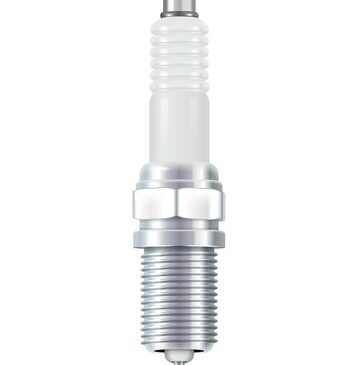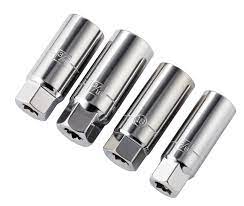-
Introduction
A spark plug socket is a specialized tool designed for the installation and removal of spark plugs in internal combustion engines. It features a hexagonal or octagonal opening on one end, tailored to the size and shape of a spark plug’s metal shell. This socket allows for a secure grip and facilitates the application of torque during installation and removal processes. Its design prevents slippage and potential damage to the spark plug, making it an essential tool in automotive maintenance.
The spark plug socket plays a pivotal role in engine maintenance for several reasons:
- Precise Installation: Ensures the proper and precise installation of spark plugs with the correct torque, preventing issues like misfires or incomplete combustion.
- Efficient Removal: Facilitates the safe and efficient removal of spark plugs during routine maintenance or troubleshooting, preventing damage to the plugs or the engine.
- Prevention of Damage: The socket’s design prevents slippage and damage to the spark plug’s delicate components, such as the insulator or electrode.
- Optimal Engine Performance: Properly installed and maintained spark plugs contribute to optimal engine performance, fuel efficiency, and reduced emissions.
- Facilitating Spark Plug Installation
- The spark plug socket’s design allows it to securely grip the spark plug, ensuring a precise fit and facilitating the smooth installation of spark plugs into the engine cylinders.
- Ensuring Secure Removal
- During maintenance or replacement, the spark plug socket aids in the secure removal of spark plugs without causing damage, ensuring that the threads and components remain intact.
- Contribution to Engine Performance
- By enabling proper installation and removal, the spark plug socket contributes significantly to overall engine performance, ensuring that spark plugs function optimally, leading to efficient combustion and engine operation.
Design and Construction
The hexagonal and octagonal openings in a spark plug socket refer to the shape of the socket’s interior. These shapes are designed to match the configuration of a spark plug’s metal shell, which typically has a hexagonal or octagonal shape. The choice between hexagonal and octagonal openings depends on the specific design of the spark plug being used in an engine. The socket’s precise fit ensures a secure grip on the spark plug, allowing for the application of torque during installation or removal without slippage.
Spark plug sockets come in various sizes to accommodate the different dimensions of spark plugs used in various engines. The most common socket sizes are 5/8 inch (16mm) and 13/16 inch (21mm). These sizes are widely used and cover a range of spark plug dimensions found in different automotive applications. Having a variety of socket sizes in a toolkit ensures compatibility with diverse spark plug designs and engine types.
Spark plug sockets often include specialized features to enhance their functionality:

Rubber Inserts for Secure Grip
Some spark plug sockets come with rubber inserts or sleeves. These inserts provide a cushioned and secure grip around the spark plug, preventing potential damage to the plug’s ceramic insulator and ensuring a snug fit during removal or installation.
Magnetic Properties for Easy Extraction
Certain spark plug sockets are equipped with magnetic properties. The magnetic feature assists in securely holding the spark plug within the socket during extraction. This is particularly useful for preventing the spark plug from falling into the engine bay, simplifying the removal process and minimizing the risk of damage.
-
Working Mechanism
“Securing a snug fit” refers to the spark plug socket’s ability to tightly and securely grip the spark plug during installation or removal. The snug fit ensures that the socket accurately engages with the spark plug’s hexagonal or octagonal metal shell. This precision is crucial for applying the necessary torque without slippage. A snug fit prevents the socket from slipping off the spark plug, reducing the risk of damaging the plug or surrounding components during the maintenance process. The prevention of slippage is a critical aspect of spark plug socket design. Slippage can lead to inaccuracies in torque application, potentially causing damage to the spark plug or the engine. The socket’s specific hexagonal or octagonal opening matches the shape of the spark plug, minimizing the likelihood of slippage during use. Additionally, the secure fit provided by the socket ensures that torque is effectively transferred to the spark plug, facilitating precise installation or removal without compromising safety or efficacy.
The compatibility with different spark plug sizes is a key feature of spark plug sockets. These sockets are available in various sizes to accommodate the diverse dimensions of spark plugs found in different engines and vehicles. The compatibility ensures that a single spark plug socket can be used for a range of applications, making it a versatile tool in automotive maintenance. Whether the spark plug is smaller or larger, the socket’s design and size options cater to the various requirements of different engines, ensuring a secure fit and effective torque application for diverse spark plug sizes.
- Additional Features
The inclusion of rubber inserts in a spark plug socket is a specialized feature designed to provide a secure grip on the spark plug during installation or removal. These rubber inserts or sleeves are positioned inside the socket and come into contact with the spark plug’s metal shell. The rubber material acts as a cushion, ensuring a snug and secure fit while minimizing the risk of damaging the spark plug’s ceramic insulator or other delicate components. The use of rubber inserts enhances the precision and safety of the socket’s grip, contributing to effective and damage-free maintenance.
Certain spark plug sockets are equipped with magnetic features to facilitate the extraction process. The magnetic property involves a small magnet integrated into the socket, which attracts and holds the spark plug in place during removal. This magnetic feature is particularly useful in preventing the spark plug from falling into the engine bay, simplifying the extraction process and reducing the risk of damage. The magnetic properties of the socket add a layer of convenience, making spark plug removal more efficient and ensuring that the extracted plug can be easily retrieved for inspection or replacement.
Top of Form
-
Compatibility and Versatility
Spark plug sockets are designed to accommodate various spark plug sizes commonly found in different engines. The diversity in spark plug sizes arises from the wide range of engine types, manufacturers, and models. The common socket sizes, such as 5/8 inch (16mm) and 13/16 inch (21mm), are chosen to cover a broad spectrum of spark plug dimensions. This versatility ensures that a single spark plug socket can be used for multiple applications, making it a practical tool for automotive maintenance and repair tasks.
Spark plug sockets are designed to accommodate various spark plug sizes commonly found in different engines. The diversity in spark plug sizes arises from the wide range of engine types, manufacturers, and models. The common socket sizes, such as 5/8 inch (16mm) and 13/16 inch (21mm), are chosen to cover a broad spectrum of spark plug dimensions. This versatility ensures that a single spark plug socket can be used for multiple applications, making it a practical tool for automotive maintenance and repair tasks.
-
Usage Guidelines
Proper torque application is a critical aspect of using a spark plug socket. Torque is the rotational force applied during the installation or removal of a spark plug, and it’s crucial to follow the manufacturer’s specifications for the specific engine and spark plug being used. Over-tightening or under-tightening can lead to issues such as compression leaks, misfires, or damage to the spark plug threads. The spark plug socket, when used with a torque wrench, allows for precise torque application, ensuring that each spark plug is tightened to the manufacturer’s recommended specifications for optimal engine performance.
The spark plug socket plays a significant role in the prevention of spark plug damage during installation or removal. The snug fit and secure grip provided by the socket, along with features like rubber inserts, help protect the delicate components of the spark plug, such as the ceramic insulator and electrodes. By minimizing the risk of slippage and ensuring a controlled torque application, the spark plug socket contributes to the longevity and functionality of the spark plug, preventing potential issues and reducing the likelihood of costly repairs.
The spark plug socket is typically used with a ratchet or torque wrench to apply the necessary force during installation or removal. The use of a ratchet provides a convenient way to turn the socket manually, while a torque wrench ensures precise torque application according to the manufacturer’s specifications. Using a torque wrench is especially crucial, as it helps prevent over-tightening or under-tightening, ensuring that each spark plug is installed with the correct amount of force. This approach promotes consistency and reliability in engine performance, making the spark plug socket a key component in the proper maintenance of internal combustion engines.
-
Conclusion
The importance of the spark plug socket in engine maintenance cannot be overstated. This specialized tool is essential for the proper installation and removal of spark plugs, a critical component in the combustion process of internal combustion engines. The spark plug socket ensures a secure grip, preventing slippage and potential damage during these maintenance tasks. Its design allows for the precise application of torque, facilitating the correct tightening of spark plugs to manufacturer specifications. This attention to detail in engine maintenance helps prevent issues such as misfires, compression leaks, and poor fuel efficiency, contributing to the overall reliability and longevity of the engine.
The role of the spark plug socket in ensuring optimal engine performance is multifaceted. By providing a secure and snug fit, the socket enables precise torque application during spark plug installation. This, in turn, ensures that each spark plug is securely in place, minimizing the risk of misfires and promoting efficient combustion. Additionally, the prevention of slippage and potential damage to spark plugs contributes to the longevity of these critical engine components. The spark plug socket, when used with proper torque application, plays a key role in maintaining the engine’s power, fuel efficiency, and overall performance. In essence, the spark plug socket is an indispensable tool for upholding the health and functionality of internal combustion engines through meticulous maintenance practices.




